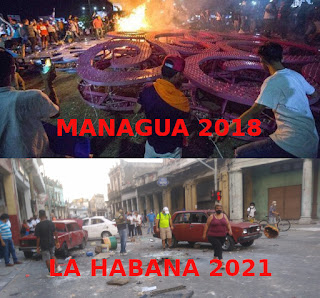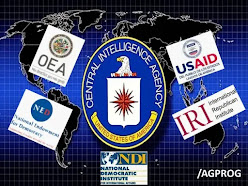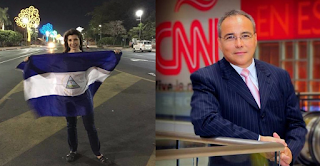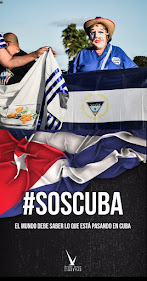Jorge Capelán, Managua con Amor, July 16th 2021
https://managuaconamor.blogspot.com/2021/07/la-habana-y-managua-dos-gol…
 On Sunday, July 11, isolated protest pickets of between 100 and 500 people, some of them violent, took place in a dozen focal points in Cuba, supposedly caused by alarm over a spike in cases of coronavirus in the country as well as discontent over the lack of food and problems with the electricity supply.
On Sunday, July 11, isolated protest pickets of between 100 and 500 people, some of them violent, took place in a dozen focal points in Cuba, supposedly caused by alarm over a spike in cases of coronavirus in the country as well as discontent over the lack of food and problems with the electricity supply.
In all twelve points, the same cries, the same slogans, the same words: "Cuba Decides", the brand of the Miami based foundation of the counterrevolutionary Rosa María Payá, with close contacts to the US establishment and the right-wing coup promoters in Latin America and Europe.
The campaign began first on social networks with a wave of tweets from the accounts of some artists and other newly created social media accounts asking for "humanitarian aid" for Cuba.
According to an investigation by Spanish analyst Julian Macias Tovar, the first account to use the hashtag #SOSCuba was one located in Spain, which between Saturday 10 and Sunday 11 posted more than 1,000 tweets and a retweet frequency of 5 messages per second.
Early on Sunday morning, the Western media began to agitate reporting a "humanitarian crisis" in Cuba, despite the fact that the island, with mortality levels of 0.65%, two national vaccines approved and more than a third of the population fully vaccinated, is one of the countries in the hemisphere least affected by the coronavirus. Videos, often fragmentary, of looting, attacks on public property and police circulated on socail media networks.
Within a few hours the trend #SOSCuba became global. The world's media, dominated by Western outlets, began to fill with headlines not only about the "humanitarian crisis" in Cuba, but also about a "popular revolt" against the "regime". It made no difference that demonstrators defending the government and the revolution took to the streets of all the island's cities and were overwhelmingly in the majority on the ground: the false insurrectionary narrative has been established in a large part of the global collective subconscious.
Never mind that just a couple of weeks ago the UN for the umpteenth time voted almost unanimously against the U.S. blockade of the island, a few clicks were enough to create a virtual climate conducive to the idea that it would be positive to "help" Cuba humanitarily, that is, to send weapons and all kinds of military means for violent groups inside the island to cause chaos, and if that were not enough, to put boots on the ground as well.
Now it is the turn of "Havana", supposedly "softened up" by 62 years of a blockade brutally tightened by Trump and continued under Biden, who before assuming the presidency had promised the opposite. 'Fourth generation' war, 'hybrid', 'soft coup', 'color revolution' in short.... there is a saying that, adapted to the circumstances, "the child loved (by the empire and its puppets) has many names..."
"We are in the presence of a preconceived script and for Nicaraguans it is not going to be difficult to understand it, because they have already lived through it themselves," explained the Cuban Ambassador, Juan Carlos Hernández Padrón, this week on local television. Hernández Padrón himself lived those decisive months between April and July 2018 in Managua during the defeated "soft coup" attempt of 2018.
It is true that many of the strategies deployed by the empire to destabilize Cuba and Nicaragua have also been used, for example, in Venezuela and Bolivia, but what happened this week in Cuba, presents some striking parallels especially with what happened in Nicaragua three years ago. The first and the second victorious socialist revolutions in Latin America received the same imperialist treatment. In both cases, the objective was the same: to damage the country's institutional order and sovereignty so as to force "regime change" via foreign intervention.
Let us look at the similarities:
 Long-term planning.
Long-term planning.
The permanent U.S. financing of the counterrevolution in Cuba is well known, but in Nicaragua this large-scale financing of the anti-Sandinista right wing has also been permanent, intensifying after the Sandinista Front returned to power in 2007.
In Cuba, President Biden's campaign promises to re-normalize the relations with Cuba shattered by his predecessor Donald Trump were totally ignored by Biden himself, who instead took advantage of the grave situation caused by Trump's tightening of the blockade to attempt a "regime change" operation.
In both Cuba and Nicaragua, the United States created and financed "independent media" that for years have been disseminating distorted information, establishing consumer niches by targeting social origin, age groups, etc., accustoming them to an increasingly confrontational rhetoric based on half-truths and distortions, seeking to sabotage current institutional stabiity.
While in Cuba, in addition to the manipulation of the difficulties caused by the U.S. blockade, an appeal was made to the supposed freedoms of the Cuban people, in Nicaragua, the speeches were focused on promoting gloomy visions of the future and, above all, on sowing the perception that a dictatorship was being established when in fact what was taking place was a very strong process of Sandinista accumulation of an electoral majority and popular support by means of the restitution of people's rights to education, health, housing, transportation, public space, culture and identity.

U.S. Ambassador Laura Dogu visits the facilities of the
facilities of the coup media "100% Noticias" in Managua
Shortages, real or invented, alleged government mismanagement, dictatorship, police corruption, arbitrariness of the mass organizations, violence, and the alleged need for change were common axes of this type of propaganda, both in Cuba and in Nicaragua: In Nicaragua the "soft coup" counted on the television channel 100% Noticias (which had signed a cooperation agreement with Cuban counterrevolutionary Yoani Sánchez's 14yMedio media outlet), Confidencial, La Prensa, Artículo66, BacanalNica and others, in addition to a myriad of Facebook pages and Twitter accounts. In Cuba, the analog was media such as El Estornudo, ADN Cuba, Ciber Cuba, Periodismo de Barrio, and also the usual myriad of social media accounts.
The para-State element
The embassies of the United States and other countries, especially European, played a fundamental role in the organization of the "soft coup", both collecting intelligence and coordinating the protagonists on the ground. In Nicaragua, U.S. Ambassador Laura Dogu for several years conducted a public diplomacy apparently totally contrary to the real work she was doing, which was to prepare the "soft coup" against the Sandinista government. Both in Cuba and in Nicaragua, the U.S. Government was very careful not to appear as the instigator of the coup, even though it is impossible to conceal the ultimate origin of the funds used and the ultimate interests served by the efforts at "regime change".
Fraudulent money
To fund the destabilization activities based on projects and specific tasks to be carried out, people on the ground and various subcontractors used fraudulent money triangulation schemes. In Cuba, destabilizing activities are financed by sending cash through emissaries, as well as by the use of access to courses, awards, scholarships, and so on as well as telephone charges paid for overseas.
Trials
In both Cuba and Nicaragua there were preparatory incidents prior to the launching of the "soft coup". In Cuba, it is well known the case of the so-called "San Isidro Movement" at the end of 2020 when what at the beginning seemed to be a series of more or less justified claims of artists towards the cultural authorities soon degenerated into a series of provocations offensive to public morals and open demands challenging the country's institutions. A similar provocation, albeit on a lesser scale, took place at the end of June with the entry into the country of Hamlet Lavastida, someone who from abroad had made repeated calls from the Internet to violate the laws and was prosecuted on Cuban soil for incitement to crime. In Nicaragua, first the OccupyINSS Movement in June 2013, resulted in a failed attempt by right-wing youth organizations to instrumentalize the situation of pensioners and then the campaign using environmentalist pretexts to exploit a fire in the Indio Maiz Reserve in Rio San Juan, played a similar role with the aim of testing the various coup strategies and measuring the response of the authorities to those aggressions.
Leadership a la carte
Promotion of "new leadership" from various social sectors, such as lgtbq, gender, legal, artists, environmentalists and others that makeit possibleto diversify the transmission of the same messages, butsuggesting they come from a movement supported by a broad majority of society. Unlike organic social movements, which emerge from intrinsic social contradictions, these "leaderships" show unusual rhetorical violence and an unusual propensity to ally themselves with ultra-right sectors, often with diametrically opposed positions. For example, groups claiming to defend gay rights suddenly ally themselves with openly homophobic characters and sectors.
Self-promotion
Trainings, awards and international events that receive wide media coverage abroad in order to give prestige to the imperialist opinion matrix as well as media visibility to the leaderships they intend to promote. For example, in Nicaragua in 2018, , during the "soft coup", several former Sandinista intellectual figures (Sergio Ramirez, Ernesto Cardenal and Gioconda Belli) linked to the coup mongering opposition received several international awards. In Cuba, Rosa María Payá's organization in Miami organized an international seminar in which it gave awards to well-known figures of the ultra-right in the European Parliament.
Optimal timing
Selecting the most opportune moment, of maximum propaganda impact, to launch the "coup". In the case of Nicaragua, after the disinformation campaign on the fire in the Indio Maiz reserve, it was decided to launch a full-scale coup on the occasion of the reform of the pension system, the content of which was very well known to the coup bosses, since it had been discussed with their leaders for a long time. In Cuba, after the incident concerning the return to the country of Hamlet Lavastida, it was decided to launch the real coup on July 11, taking advantage of an upturn in Covid-19 cases on the island. Both in Cuba and in Nicaragua, the pretexts for the coup were totally exaggerated and taken out of context in order to implant the matrix of coup supporting opinion both internally and externally.

Nicaragua: if it was to denounce real violations of
human rights, the "Community Norms" were inflexible...
Facebook and Twitter
The use of social networks as political-military tools for propaganda and social control. When the time came, both in Cuba and Nicaragua, social networks exploded with the hashtag "#SOS" (#SOSCuba, #SOSNicaragua...). Out of nowhere, accounts of unknown or little-known groups emerged repeating the same themes, as well as fake accounts often "bots" posting and forwarding messages at a pace impossible for a human being.
In both Cuba and Nicaragua, this automated propaganda campaign came from abroad. In the case of Nicaragua, it became notorious that "farms" of "bots" operated in El Salvador sending out thousands and thousands of messages per minute with means well beyond the reach of non-professional hacker groups. Propaganda in social networks was characterized by its high emotional impact and aggression.
In both Cuba and Venezuela, images from other countries were posted and all kinds of falsehoods were told in order to deceive the population both internally and externally. In both Cuba and Nicaragua, the "community rules" of the social networks were selectively applied against those who defended the government or did not toe the line of the coup propaganda, while the promoters of the coup were free to publish whatever they wanted without any kind of censorship.
Although there is no evidence, it is logical to assume that social network traffic has been and continues to be used by the U.S. Government as a source of intelligence to search for all kinds of correlations and patterns of social interaction of the populations targeted by the policy of aggression.

...but if it was a question of stirring up hatred
for the coup the criteria were different....
Influencers
The use of "influencers" to promote the coup, targeting different social segments but especially young people. While in Nicaragua the account of Miss Nicaragua was used, in Cuba the account of porn actress Mia Khalifa was used. These "influencers" were quickly joined by others including artists, journalists and other personalities.
In the case of Nicaragua, for example, singer Katia Cardenal, previously not publicly identified as a government opponent, spread serious lies, such as that the Nicaraguan government was spraying the city of Masaya with chemical weapons, which was later republished by global influencer Bianca Jagger and went around the world.
The media dictatorship
Western media dictatorship outlets such as CNN, the newspapers El País and ABC in Spain, the EFE and DW agencies in Europe, and many others, joined the shrill chorus of lies about what was happening in Cuba on July 11th and they did the same about what was happening in Nicaragua in 2018.
They invented resignations of ministers, competing among themselves to see who could distill more venom against the revolutionary government, they omitted as far as possible the violent character of the coup demonstrations just as they did the mobilization of the Cuban and Nicaraguan peoples in defense of their respective revolutions.

Patricia Janiot (left), Colombian Univision anchorwoman, could not resist
putting the microphone aside to join in the "peaceful protest" in Managua
in 2018... even though there weren't many "protesters" on the street.
For his part, Camilo Egaña in July of 2021from CNN explained to
the public that the US blockade against Cuba simply does not exist


 In both Cuba and Nicaragua, whose peoples have a very revolutionary nationalism, the national flag was the symbol of choice.
In both Cuba and Nicaragua, whose peoples have a very revolutionary nationalism, the national flag was the symbol of choice.